PAGE 62 – June 2007
H O T I D E A S F O R S M A L L R A I L R O A D S

It’s often been said in these pages that a minimum-space layout that looks great
and is fun to run can be built in any scale, from Z to G and up. This month we demonstrate
the point by showing you an inspiring layout in every commonly-used scale!
(Yes, I know that there are more scale/gauge combinations than we’re showing
here — see my Table elsewhere on the site — but this issue covers the scales
and gauges that are in widespread use world-wide as of 2007 CE.)
Z SCALE (1:220, 6.5mm gauge)
The smallest of the popular commercially-available scales is Z, first developed by Märklin and now with a number of active manufacturers. Carsten Weye Jensen, from Holstebro, Denmark, is a long-time Z scale advocate and has presented layouts in Scrapbooks #41, #47, #49 and #52a. He recently designed a Z scale Tymesaver, a variation on John Allen’s Timesaver layout, along with an extra-small version that might be the smallest Tymesaver ever designed!
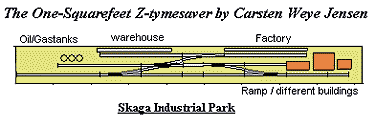 At 10x92cm this tiny Tymesaver layout measures just one square foot in area. Trains enter the scene from a cassette that is attached at the left side of the layout. Most of the industries will be placed on the backdrop, to keep the size down to 1 sq.ft. All trackage is by Märklin. At 10x92cm this tiny Tymesaver layout measures just one square foot in area. Trains enter the scene from a cassette that is attached at the left side of the layout. Most of the industries will be placed on the backdrop, to keep the size down to 1 sq.ft. All trackage is by Märklin. | 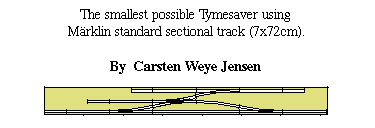 Just to show the space-saving capabilities of Z scale, Carsten designed this absolute-minimum space layout, at 7x72cm probably the smallest possible Tymesaver using Märklin sectional track. Carsten remarked, “It would have to be used with very short locomotives and cars!” Just to show the space-saving capabilities of Z scale, Carsten designed this absolute-minimum space layout, at 7x72cm probably the smallest possible Tymesaver using Märklin sectional track. Carsten remarked, “It would have to be used with very short locomotives and cars!” |
N SCALE (1:160 or 1:148 (U.K.), 9mm gauge)


Paul Atkinson, who lives in the U.K., built the 900x140mm (35×5.5in) Padeswood Yard layout for his son, who lives in Australia. As a result this N scale railway is lightweight (no more than 6 kg including shipping box), very compact, and extremely sturdy to withstand shipment! A special feature is night lighting for running trains in a darkened room. There’s lots more information at Paul’s website.
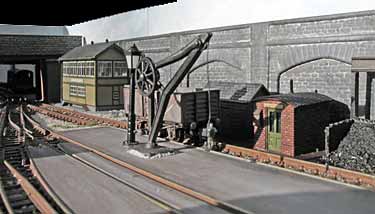
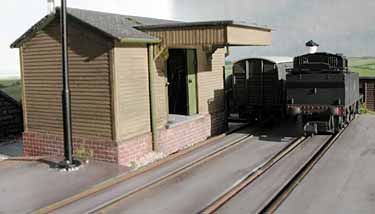
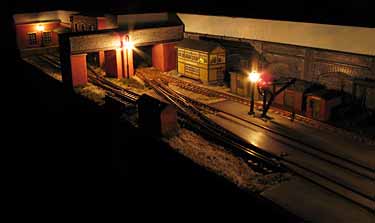
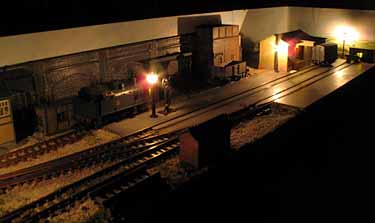
TT SCALE (1:120, 12mm gauge)

Although TT scale was invented in the U.S. over 60 years ago, most of the activity in this tiny scale is currently in Europe. Joern Pachl, from Braunschweig, Germany, builds TT layouts to recreate scenes of German railways and illustrate railroad operating practices. He’s a professor at Braunschweig Technical University, specializing in raiload technology.
Recently Joern, possibly influenced by this site, undertook to build his first micro layout — this time with an American prototype! His 150x15cm (59×5.9in) layout (see plan above) represents a single track line through an industrial area in the Chicago region in the late 1950s. Joern explains, “The track running along the front edge of the layout is a ‘dark territory’ main track operated under Timetable & Train Order. Except for a short stretch on the right end of the layout the entire main is within yard limits. All other tracks are industrial spurs. The two crossovers very close to each other form a small loop that allows running around a single car. Thus, the track configuration forms some kind of a ‘micro timesaver’.”
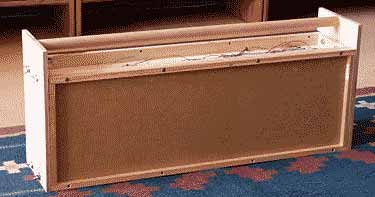
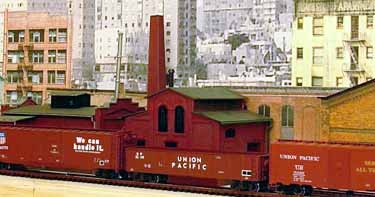
The layout is built in two modules that can be folded into a transport box with the backdrop plates forming the sides (left photo above). Joern can carry it even on public transit. Building a U.S. prototype layout in TT proved to be a real challenge, because virtually no trains or structures are available as commercial models. Most of the models were scratchbuilt or adapted from European kits. The background provides a stunning “sense of place” to firmly site the model in Chicago. For more photos and information about this striking micro layout, see Joern’s website.
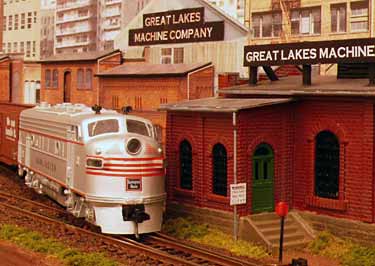
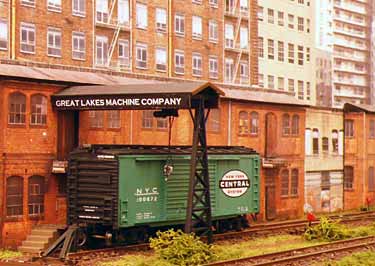
HO SCALE (1:87, 16.5mm gauge)
Another approach to an urban switching setting is this HO module by Charles Hansen, from Boston, USA. The module is designed to NMRA standards with a double track main line running through it at the left, allowing it to be connected with other modules. Charles has added an independent switching layout at the lower level, winding through the urban canyons beneath the elevated main, so at home the layout is a standalone switching pike. A viewer suggested he name it Worcester, after an industrial city about 50 miles from Boston.
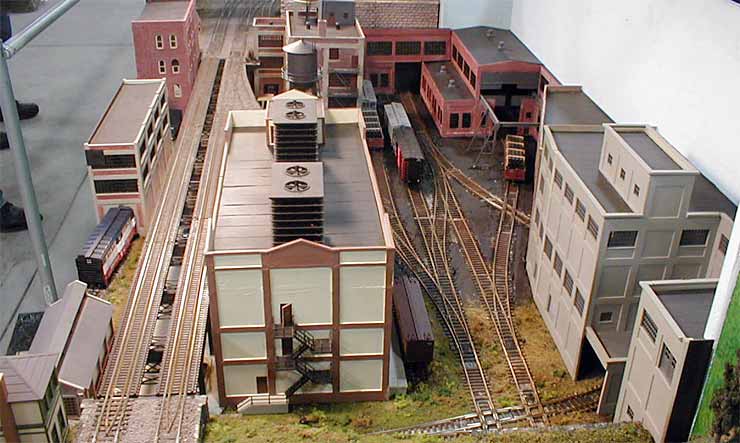
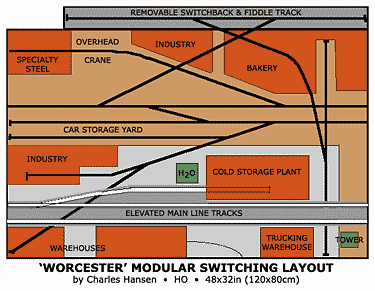
Charles explains parts of the design, “I realized that a runaround track would be a waste of space and car storage, so came up with a design where all the tracks are facing the same way, including one that is perpendicular to the front of the module and is reached by running through some buildings. All the ‘reversing’ (switchback) tracks are just barely long enough for my 44 tonner loco and one 40ft car. I even had to hollow out the ends of the plywood frame to get enough clearance.
“One track pops through the back of the module, then runs the other direction before re-entering — sort of a K-shape with a hidden crossing. However, I really like the dramatic effect of the train coming right at a spectator. For now I use four Walthers crossings for this complex trackwork, having mangled two of them to get the rails closer to 80 degrees than 90. I have a custom made crossing from Railway Engineering on hand, but have so far been intimidated from installing it by the thought of all the rail cuts and leads that will be required — I think it’s 16 of each!
“One of the things I’ve done is deliberately used tall industries to shield some of the yard tracks. I tried to approach the overall design as an architectural study, in terms of using masses and forced sight lines. As for operation, I have four lower-level industries and spot a car at each — boxcars at two locations, covered hopper at the bakery (or whatever it is) and a short gondola with pipe loads at the steel works. I have a second car of each type in the yard tracks and switch the car at each industry, one at a time. I like to think that it’s a lot of railroading in ten square feet!”
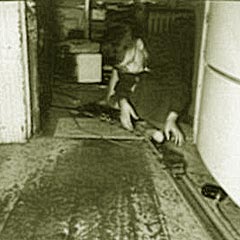
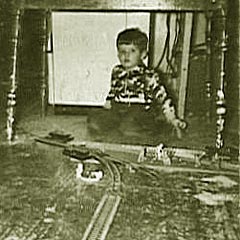
HOe/HOn30 SCALE (1:87, 9mm gauge)
HOn30 (called H0e in Europe) is perhaps the most popular narrow-gauge scale because you can use commercial N scale track and mechanisms. An outstanding example of modeling in this scale is Uivernest, made by Jan Van Mourik from the Netherlands.
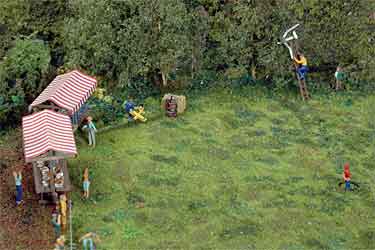
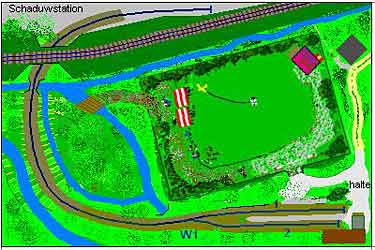
Measuring 1000x667mm (39x26in), this scenic layout centers about a model airplane show, with narrow-gauge trains bringing people to the show. Trains arrive from a backstage fiddle track and include a railcar as well as a loco-drawn old-time open coach. Scenic highlight is the central field, where an enthusiast (dressed in red) is flying a yellow biplane on a control line. Motorized, the plane circles the field realistically. The field itself is built as a separate unit so the animation can be removed for maintenance. For more photos of this outstanding scenic work, see Ted Polet’s album. (Photos by Jan Van Mourik.)
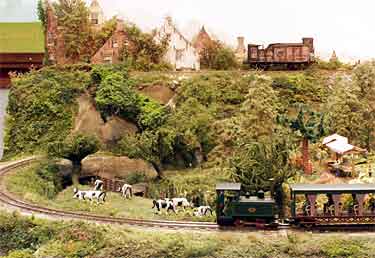
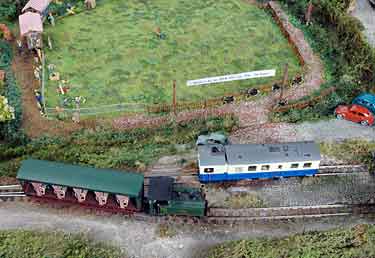
OO SCALE (1:76, 16.5mm gauge)
Britain’s most popular scale is OO, slightly larger than HO but running on the same track. An interesting example, particularly good for beginners because no curved track is needed, is Kidmore End, under construction by David Mitchell, from Reading.
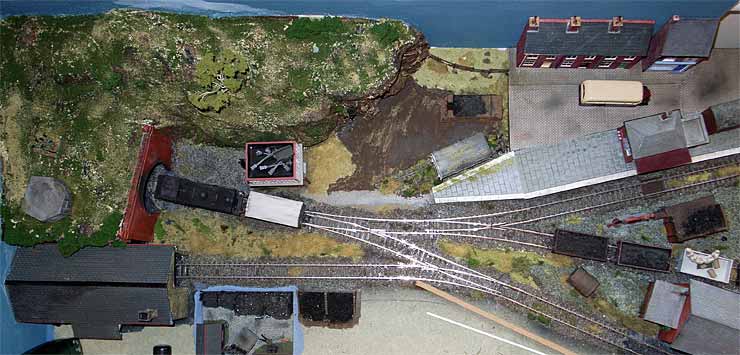
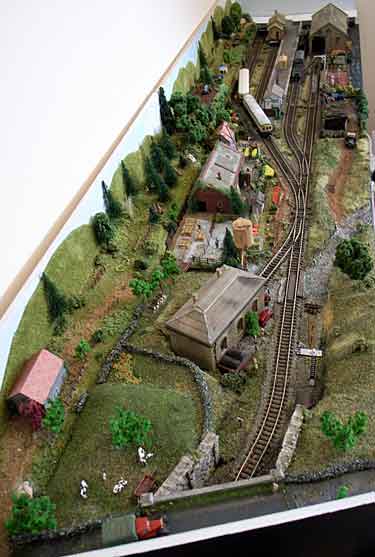
The 40x22in (102x56cm) layout “is from ‘The Art of Compromise’ series of articles in Railway Modeller magazine of March and May 2004,” David reports. “Trackwork is Peco Settrack, no curves are used, and there are just three points (turnouts)—two Y’s (wyes) and a lefthand.” Fiddle yard (beyond the tunnel) and more scenery are still to come.
David is still deciding what to put at the front of the layout (bottom of the photo above). “At a minimum,” he says, “I could sensibly have reduced the baseboard depth to 20 inches.” Suggestions, anyone?
OO9 SCALE (1:76, 9mm gauge)
Analagous to HOn30, OO9 is the most popular British narrow-gauge scale. But it is not confined to the U.K., as this layout shows. It’s the marvelously scenic Castle Rock, by Henk Wust from the Netherlands. Henk is active in the Dutch chapter of the OO9 Society, one of the world’s most energetic modeling organizations.
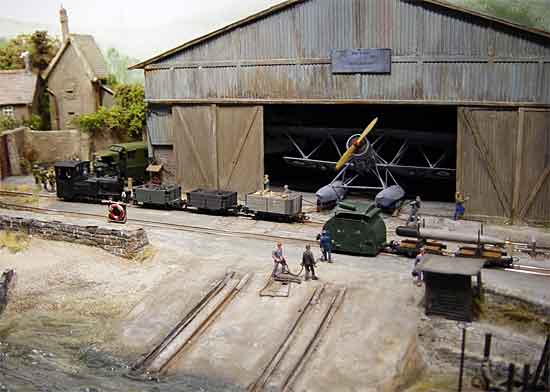
Henk’s “long, thin” layout has an unusual setting: a British Navy seaplane base with its own narrow-gauge railway to transport ammunition and supplies, modeled in part on the base at Calshot with touches of other bases added in. The time is September 1939.
Highlight of the layout is the aircraft hangar with a seaplane emerging from the doors, ready to roll down the ramp into the water. The propeller turns realistically, a well-placed bit of animation. The hangar itself is only a couple inches deep — in fact, the seaplane has no tail! The rest of the scenery is carefully planned for shape and texture, and Henk has used forced perspective in several places to create a sense of depth in his narrow shelf. The lighthouse, for example, is modeled to 1:100 scale. The photos below tour the layout from left edge to right edge. For a good many more photos see this album. (These photos by Jan Van Mourik.)
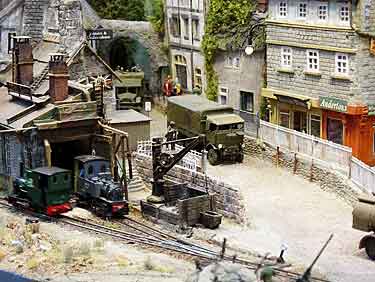
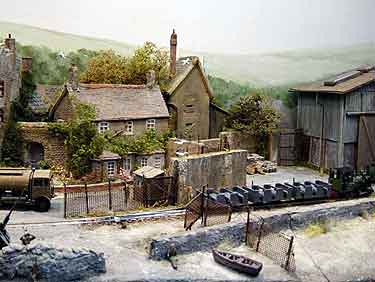
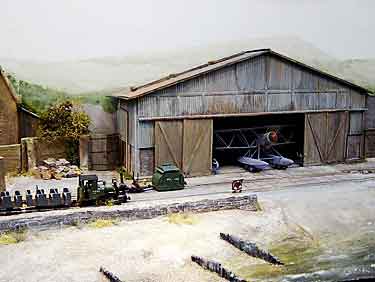
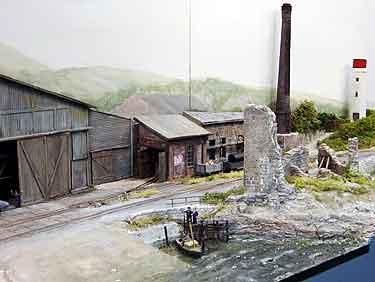
O SCALE – 3-RAIL (1:48, 1¼in gauge)
Although three-rail tubular track was the way many of us got started in model railroading, we tend to view it these days as “toy trains.” But there is a growing band of modelers who create scale layouts (to 1:48 in the U.S. and 1:43.5 in the U.K.) running on those tracks with the electrically convenient center rails. This layout, however, is not one of those. It’s offered instead as a tribute to the intrepid determination of model railroaders to build layouts despite seemingly insurmountable obstacles. Read on.
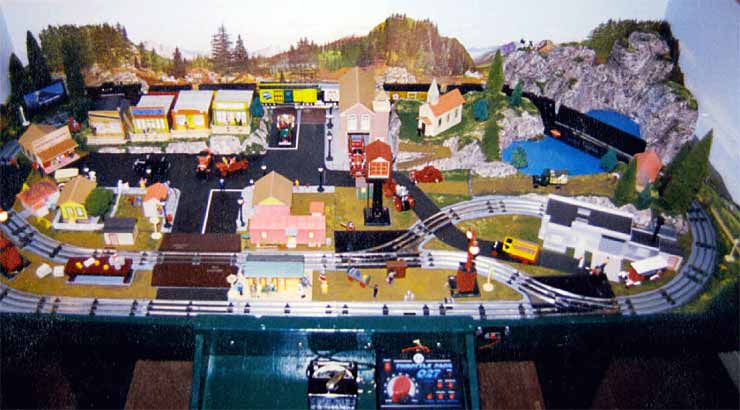
Ed “ICE” Berg, from Las Vegas, Nevada USA, built the 40x84in Shawano & Twin River Valley RR in 2000, while he was stationed at Osan AB in South Korea. The creation is usually referred to as the Osan line. It was built despite there being no workshop facilities nor model supplies available for 800 miles in any direction. The baseboard table, for example, was built and painted in sections while Ed was on leave at home in Las Vegas, then shipped to him at Osan for assembly. Ditto the backdrop (there is no foamcore in Korea).
Rolling stock is new Marx (now Ameritrains), which is smaller than Lionel or MTH and allows more stock on a small layout. Besides, Ed notes, “it has all the makings of a my favorite narrow gauge/shortline look and has a lot of modeling potential in that regard.” Here are a couple closeups.
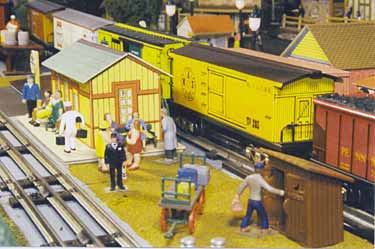
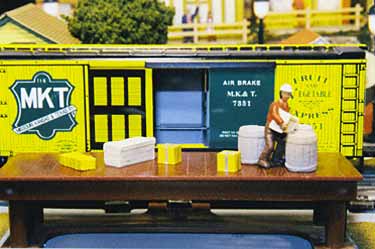
Scenery? Removable hills were made from foam blocks (mail order from the U.S.). Ed notes, “The paint used on the hills required a trip to the Yongsan Army Post in Seoul. I bought two different brands of flat latex house paint (1 brown, 1 white) at the PX and brought them back on the shuttle bus. After I mixed the two to get a nice tan and applied the mixture to the mountain, the two brands began to separate! Luckily, in a serendipitous way, the final color/effect turned out really nice.”
Structures? They’re made of paper! No sheetwood or plastic was anywhere to be found, so the buildings were all scanned from ancient issues of Toy Trains magazine, then printed on the computer, cut out and assembled. Here are some examples (these will be items of nostalgia for some of us old-timers).
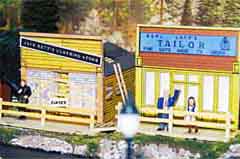
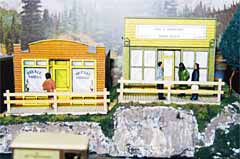
And one final touch involved the sound system. “I used a ‘Sounds Alive’ tape for background sounds (Model T engine sounds, birds chirping, etc) and a CMI sound system for the synchronised engine sounds. The ‘Sounds Alive’ tapes were originally produced on endless loop cassettes, but I transferred the recording to 90-minute tapes after finding that endless loop tapes tend to jam up easier in cheaper cassette players (which was what were available).”
Ed shipped the layout home to Las Vegas when his tour of duty ended, and it now resides there — a tribute to the power of Vane Jones’s immortal advice to everyone facing shortages of modeling materials: “SCROUNGE!”
0 SCALE (1:45, 32mm gauge)
European normal (standard) gauge two-rail layouts in 0 scale are built to 1:45 proportion, running on 32mm gauge, which is virtually identical to 1¼in gauge. Normally we think of 0 scale layouts as much too large to be considered in a website for small layouts. But I recently published one of my designs for a micro layout in O standard gauge, and frequent-contributor Herbert Fackeldey, from Aachen, Germany, has designed another.
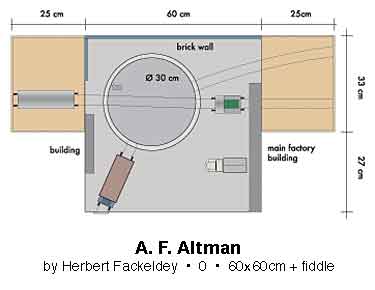
This small industrial switching layout measures just four square feet in area (not counting the fiddle yards). Even with fiddles, it’s very small and portable. And it even has a prototype — at F. A. Neumann Works in Eschweiler, which builds heavy equipment, particularly silos, for industrial plants.
The factory is immediately adjacent to Eschweiler main station (on the Aachen-Cologne main line) and was connected to it until fairly recently. Herbert noticed the factory’s sole locomotive, a Deutz four-wheel shunter, sitting on the turntable as he passed in the top deck of a bilevel train en route to Cologne. He realized that this little industrial line would be an ideal way to show off his small collection of 0 scale rolling stock! Because the track arrangemen is not identical to Neumann’s, Herbert calls his layout A. F. Altman.
The turntable is long enough to hold the switch engine and one standard European car measuring 9 or 10 meters. The prototype locomotive is currently used to shuffle around the products between the various buildings of the factory, but there is no doubt that the connection to the DB was once used to get supplies in and finished equipment out. So this little layout can be a busy place! There’s a photo online of the prototype F. A. Neumann locomotive on the turntable.
O-16.5 / On30 SCALE (1:43.5 / 1:48, 16.5mm gauge)
The fact that HO gauge (16.5mm) is equal to about 30 inches in U.S. O scale (28 inches in the U.K. version) has long been a delightful source of narrow gauge track and mechanisms for O scalers. In recent years the entry of Bachmann into the commercial On30 market has spurred popularity of the scale in the U.S. Active work by the 7mm Narrow Gauge Association in Britain has helped create a similar growth effect. Here’s a very small British layout to illustrate this scale; the track plan would also work for U.S. narrow-gauge trains.
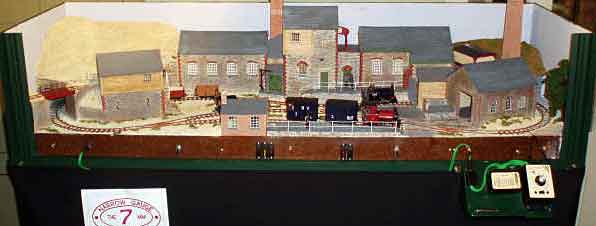
Peter-John Sanders, from Balmer, North Shropshire in England, began construction of the Blackwood Valley Railway in O-16.5 when he was 12 years old. Now 16, he has just recently exhibited the layout for the first time, winning an award and gathering invitations to several other exhibitions. Taking his inspiration from the celebrated Snailbeach District Railway, a former narrow-gauge line in Shropshire, P-J built a commendable 54x17in O-16.5 scale line.
All structures are scratchbuilt by P-J from thin marine plywood covered with plasticard (styrene) sheeting. The track plan can be deduced from the aerial photo below. It is an end-to-end switching line, and P-J now has three model steam locomotives working the line. He has also put together a website about the BVR.
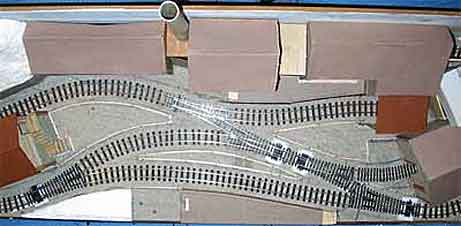
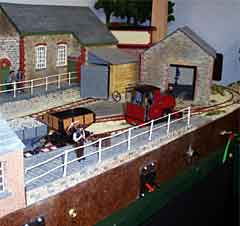
G SCALE (1:22.5, 45mm / 1¾in gauge)
The “G” stands either for “Gross” (big) or “Garten” (garden) … either way, you would not normally associate this scale with small layouts. But ingenious model rails have found ways to pack G scale layouts into very small spaces — and there have been at least a dozen small G layouts published in these pages. Here’s a new one, very different from the rest.
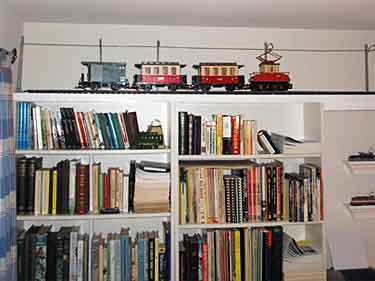
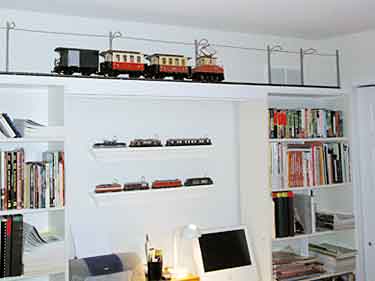
Meet the Furlong Pendelbahn (Furlong Shuttle Railroad), built by Dick Bell from Furlong, Pennsylvania USA. A long-time traction aficionado, Dick realized one day that “there was just enough space above the bookshelves in my office/guest room that was underutilzed.” He immediately constructed an LGB single track line, 10in wide by 13ft long — at just over 10 square feet, a small layout by anyone’s definition.
Dick comments, “The layout currently lacks scenery, and the distance between terminals is short, but service is frequent and reliable. Ordinarily, this is the train that usually occupies the right-of-way under our Christmas tree. Now it is available for use all year round. Scenery in the form of a backdrop and false flat stations at each end is planned.”
Look! Up in the air! It’s …
Gn15 SCALE (1:24 – 1:20, 16.5mm gauge)
A relatively new scale, invented around 2000, Gn15 is a fast-growing phenomenon. It also happens to be the scale I work in much of the time. But even more important, the prolific Giles Barnabe, from London, England, has just built and exhibited a new Gn15 layout. Here’s a peek.
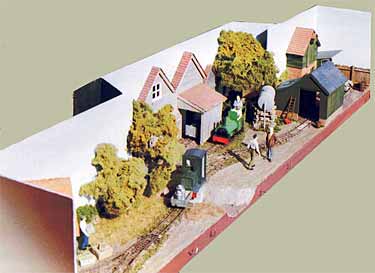
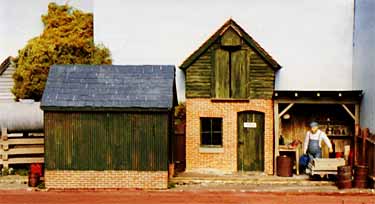
Futtock’s End is a 54x12in Gn15 estate railway that hauls supplies into the estate and takes produce out. Fiddle yards are in the left and right rear corners.
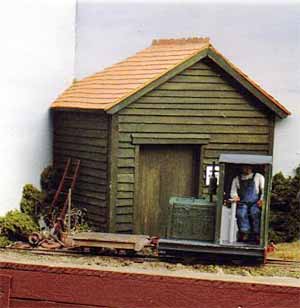
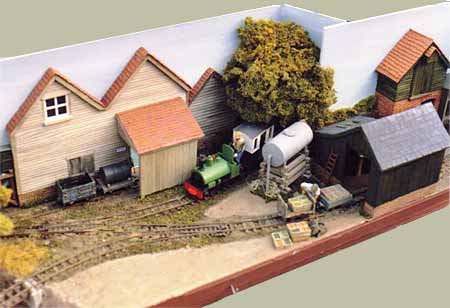
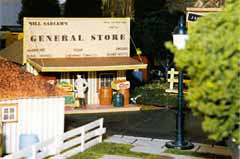
Leave a Reply